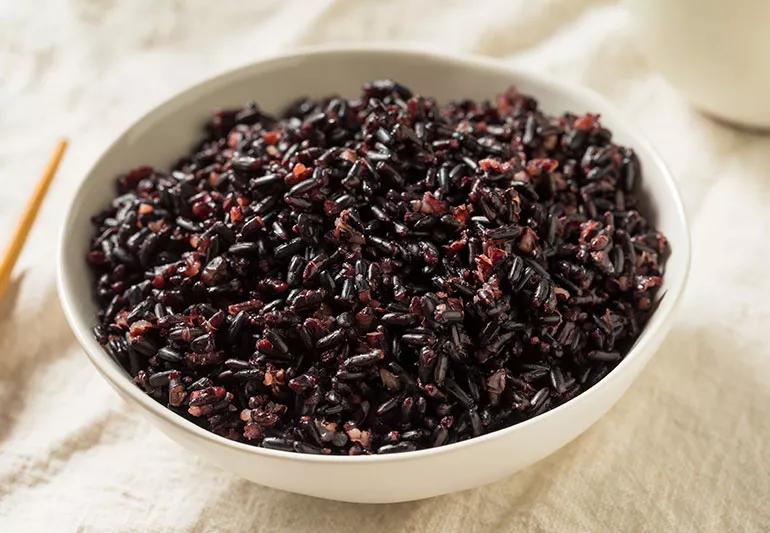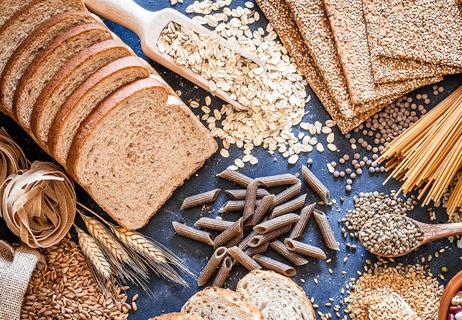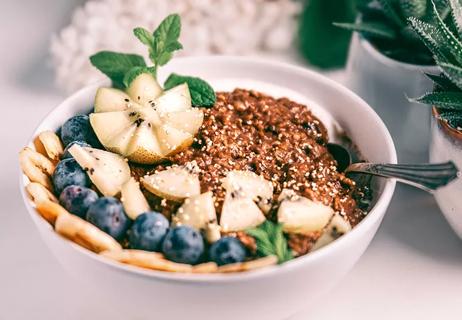No longer forbidden, this rice is more nutritious than other types

If you’ve ever eaten black rice, then you can appreciate its nutty, slightly sweet taste, chewy texture and exotic purple-black hue. But this unique rice is more than delicious, it’s incredibly healthy — and increasingly considered a “superfood” among rice.
Advertisement
Cleveland Clinic is a non-profit academic medical center. Advertising on our site helps support our mission. We do not endorse non-Cleveland Clinic products or services. Policy
“Black rice has been slow to cross over to places outside of Asia, but we are finally starting to understand its benefits as a healthy, appetizing and beautiful food,” says registered dietitian Beth Czerwony, RD.
Czerwony dives into the history of black rice and how it can boost your health.
Forbidden black rice refers to a type of heirloom rice that has been part of the Asian diet for thousands of years. It belongs to the species Oryza sativa, whose other varieties include Indonesian black rice and Thai jasmine black rice.
Black rice may be long-grain, medium or short-grain. Grown on a small scale, black rice has never been as common as other types, including white, brown and red rice.
Early research suggests that black rice is even more powerful than blueberries in its antioxidant effects (if you can imagine that). It may also help boost immunity and protect your body against cardiovascular disease, diabetes and other conditions.
Black rice (also known as forbidden black rice or emperor’s rice) is used in traditional Chinese medicine. It was once reserved only for the wealthy and powerful to ensure their health and long life. No one else was allowed to eat it.
Fortunately, that’s no longer the case, and black rice is widely available in restaurants, grocery stores and online.
Advertisement
Black rice is especially high in nutrients compared to other types of rice. But it’s particularly rich in anthocyanins — powerful antioxidant pigments that protect your body’s cells from damage. Anthocyanins are what give this rice its unusual color, similar to eggplant, açai berries, blueberries and Concord grapes.
A review of research on forbidden rice shows that it’s linked to numerous benefits, such as helping to:
We need more research, says Czerwony, but early studies into black rice nutrition are promising.
“We know forbidden rice is high in nutrients and antioxidants, which help protect our bodies against disease,” she continues. “It’s also low in sugar, fat and salt, which is important when we’re looking to improve our diets and maintain health.”
Forbidden black rice may help:
Black rice contains a boost of nutrients that help your body work properly, such as vitamin E, calcium and potassium. It has more protein, fiber and iron than other types of rice and contains high levels of:
For example, a one-cup serving (100 grams) of prepared black rice contains 2.4 milligrams of iron — more than 10 times the amount in unenriched white rice. It also contains 8.89 grams of protein vs. 6.94 grams in white rice.
Carotenoids (a type of antioxidant) help protect the healthy cells in your eyes, especially your retinas. Carotenoids have also been shown to reduce the potentially harmful effects of ultraviolet (UV) radiation and prevent the growth of cancerous cells. Vitamin E in anthocyanin also protects the health of your eyes, as well as your skin and immune system.
Antioxidants and plant-based chemicals (phytochemicals) can improve your body’s sensitivity to insulin. This process helps you better use glucose. It slows the rate at which your body absorbs sugar and lowers sugar levels in your blood.
The outer layer of a black rice grain contains a higher level of the antioxidant anthocyanin than other types of rice and many other foods. Antioxidants help prevent cardiovascular disease, improve brain function and protect against cancer caused by free radicals damaging your cells.
Protein and fiber in black rice can also help to:
Plant-based nutrients and antioxidants in black rice help reduce swelling in your body. While we need more research, says Czerwony, eating black rice may ease symptoms of inflammatory conditions such as arthritis and dermatitis.
Advertisement
Black rice is naturally free of gluten, a protein found in certain types of rice (like instant and flavored rice) and whole-grain products with wheat, rye and barley. “People with celiac disease or gluten intolerance can safely eat black rice,” says Czerwony.
While black rice is generally safe (and no longer restricted to emperors), it contains the heavy metal arsenic, as does all rice. To reduce your risk of eating too much arsenic, rinse black rice while it’s dry, before cooking. It’s also best to eat black rice in moderation, as too much may cause gastrointestinal effects like an upset stomach, bloating or gas.
Wondering how to cook forbidden rice? Due to its chewy texture, it’s best to pre-soak the rice for 30 minutes to 60 minutes. Then boil, fry, steam or even pressure cook black rice, though it generally takes longer to cook than other types (typically 30 minutes to 60 minutes). Follow directions for the particular brand of rice and your recipe.
Store uncooked black rice in an airtight container in a cool, dry, dark place for up to six months. Cooked forbidden rice can be kept in the refrigerator in an airtight container for three to five days.
Use black rice in soups and salads, stir-fries or desserts. You’ll soon fall in love with its nutty flavor, the chewy texture and the nutrition boost — not to mention how glamorous it looks on your plate!
Advertisement
Learn more about our editorial process.
Advertisement

A whole grain, sorghum is chock-full of antioxidants and nutrients that boost energy, support a healthy immune system and more

Options like almond, oat and coconut flours offer a decent amount of protein and fiber

Sourdough can be healthier than some other bread choices — but that doesn’t give it ‘health food’ status

Eating this grain could help keep tabs on your appetite and protect against diabetes and cancer

Made from sprouted whole grains and legumes, it’s low calorie and full of fiber and protein

A diet rich in whole grains improves gut health, protects your heart and may reduce cancer risk

Move over oatmeal! It’s time to make room at the table for these grain options

The answer is clear, but there are factors to consider

If you’re feeling short of breath, sleep can be tough — propping yourself up or sleeping on your side may help

If you fear the unknown or find yourself needing reassurance often, you may identify with this attachment style

If you’re looking to boost your gut health, it’s better to get fiber from whole foods